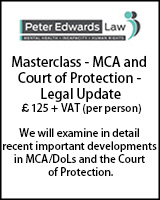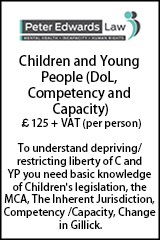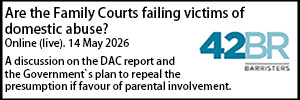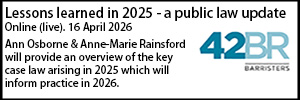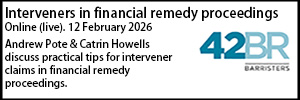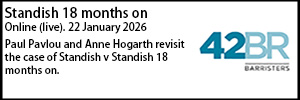Children law update: April 2025
- Details
Michael Jones KC analyses the latest children’s law cases of interest, ranging from risk assessments to the designation of local authorities for the purposes of interim care orders.
Kicking off this the first children law update of 2025, we will get started with the issue of risk assessments, or ‘assessing risk’ in care proceedings.
There are two recent Court of Appeal decisions that follow on neatly from one another in this respect, the first being L-G (Children: Risk Assessment) [2025] EWCA Civ 60 and the second being Re T (Children: Risk Assessment) [2025] EWCA Civ 93. The latter includes reference to the guidance provided by the former, hence we will focus on Re T. This involved the successful appeal against the making of final care orders by a circuit judge. The brief facts were that findings were made in 2016 in relation to the mother having caused a skull fracture to one of the subject children; there was no finding of deliberate infliction as opposed to accidental causation and there were no other matters relied upon in support of threshold. Two of the children returned to the care of the father under supervision orders and the third child remained in the care of the local authority. It transpired that the parents had never truly separated and had concealed their relationship from professionals; in March 2023 the mother gave birth to the child who would become the third subject child to further care proceedings issued in late 2023 when the local authority became aware of the history of the previous proceedings.
A Resolutions Model assessment was commissioned, however the ISW did not deem this model of assessment to be appropriate on the facts of the case. The ISW assessment concluded negatively, with concerns relating to the parents’ ability to adhere to a safety plan. There were numerous positives associated with the parents, including quality family time with the children. At the conclusion of the final hearing the judge aligned herself with the views of professionals and granted the orders sought. The Court of Appeal observed that ‘The all-important concluding section of the judgment falls well short of justifying such far-reaching decisions. There was no effective risk assessment, and consequently no proper welfare evaluation, comparison of the options, or consideration of proportionality.’
Importantly, the Court set out the structured analysis which could be adapted to the facts of the individual case, which could benefit those making decisions and those effected by them;
‘This court's recent decision in Re L-G (Children: Risk Assessment], reiterates the guidance given in Re F (A Child: Placement Order: Proportionality) [2018] All ER (D) 94 (Dec). The risk of harm, important as it is, is one of a number of factors in the welfare checklist and it has to be carefully assessed, particularly where it may be decisive.
The Children Act 1989 provides a framework within which the court assesses whether a child has suffered or is likely to suffer 'significant harm' for the purposes of the threshold for intervention, and 'harm' for the purposes of the welfare assessment. Section 31(9) defines harm in this way:
"harm" means ill-treatment or the impairment of health or development including, for example, impairment suffered from seeing or hearing the ill-treatment of another;
"development" means physical, intellectual, emotional, social or behavioural development;
"health" means physical or mental health; and
"ill-treatment" includes sexual abuse and forms of ill-treatment which are not physical.
Accordingly, the court had to address these questions in relation to each of these children:
(1) What type of harm has arisen and might arise?
(2) How likely is it to arise?
(3) What would be the consequences for the child if it did?
(4) To what extent might the risks be reduced or managed?
(5) What other welfare considerations have to be taken into account?
(6) In consequence, which of the realistic plans best promotes the child's welfare?
(7) If the preferred plan involves interference with the Article 8 rights of the child or of others, is that necessary and proportionate?’
In allowing the appeal, the Court noted the absence of any effective risk assessment in the judgment and a consequent absence of any proper welfare analysis comparing the options and considering proportionality. The approach advocated above provides a very useful guide to exactly how risk should be identified and assessed, both by Courts and professionals.
Next up, you will recall from an earlier edition of the update the decision of Lieven J in refusing to set aside adoption orders under the inherent jurisdiction on the basis that such a power did not exist. The Court of Appeal have now considered Lieven J’s decision on appeal in Re X and Y, (Children: Adoption Order: Setting Aside) [2025] EWCA Civ 2 and refused the appeal, upholding her ladyship’s judgment. You might remember the factual background to this case, which involved two children (X and Y) being placed for adoption, with the adoptive placement breaking down and both children returning to the care of the birth mother; the adoptive parent then applied to revoke the adoption orders.
Following a thorough review of the relevant authorities, Lieven J held that the court lacked jurisdiction to revoke an adoption on purely welfare grounds and she went on to record her assessment in terms of the welfare of X and Y;
‘I do however wish to note, that I accept, certainly in the case of Y, it would be in her best interests to revoke the order. She plainly finds the present legal fiction distressing and the fact that it reflects neither reality nor her own sense of self, deeply upsetting. This has been her position consistently for a long period. The position is less clear cut in respect of X. I do not intend to carry out a detailed analysis of her welfare interests given that I have found I have no power to revoke.’
The President engaged upon a thorough review of the relevant first instance and appellate authorities;
‘The key authority remains the decision of this court in Re B, which stated that the courts should be strict in their refusal to allow adoption orders to be challenged otherwise than by way of appeal. Nevertheless, that is what had happened at first instance in the decision that came to this court on appeal in Re W, and in nine of the eleven first instance cases, the exceptions being Re PW (Parker J) and Re J (Cobb J). When entertaining applications to revoke adoption orders, the High Court has relied on the dicta of Wall LJ in Webster but, as seen above, those observations did not relate to the powers of the High Court at all. Parker J was therefore correct to hold that the only remedy available to the applicant in Re PW was an application for permission to appeal out of time. The misunderstanding that there is an inherent jurisdiction in the High Court to set aside an adoption order first appears in Re W (Bodey J) and became codified as received wisdom after that, in particular in Re O (Sir James Munby P).
Evidently, the child's welfare is to be taken into account in deciding whether to grant permission to appeal out of time, but there is no support in Re B for the proposition that adoption orders can be set aside on welfare grounds. On the contrary, the development of the law in that direction has been at odds with the insistence in Re B on the inviolability of regularly made adoption orders as being the ultimate imperative. The requirement for an extension of time for appealing is an important filter in protecting adoption orders from challenge, and it should not be circumvented by the assumption of an original jurisdiction at first instance.
There may nevertheless be very narrow and specific instances in which the High Court finds it necessary to entertain an application to revoke an adoption order, but they will only arise where for some reason an appeal, in or out of time, is not possible. That was the position in G v G (Hedley J), where the special statutory environment of surrogacy made it impracticable to bring an appeal.
There may also be cases, where the failure to serve a party has been so quickly identified that the court, whether the High Court or the Family Court, can correct the position by using its powers under the Family Procedure Rules 2010.’
(This specifically related to the power to set aside a judgment or order following a failure to attend, at FPR 27.5)
‘The use of this statutory power does not amount to the exercise of an originating inherent jurisdiction……
The President also identified the potential application of the slip rule;
…. The court (High Court or Family Court) may also be able to employ FPR 2010 29.16, known as the slip rule….’
The President concluded that;
‘The conclusion that we have reached on consideration of the previously decided cases, which holds firmly that there is no jurisdiction at first instance to set aside a validly made adoption order, is on all fours with the summary of the underlying policy considerations put forward by the SoS, which we accept [paragraph 36 above]. Those policy considerations are, in turn, plainly in line with the approach of Swinton Thomas LJ, Simon Brown LJ and Sir Thomas Bingham MR in Re B. These are matters of fundamental principle with respect to adoption. Adoption orders are transformative, have a peculiar finality and are intended to be irreversible, lasting throughout life, as if the child had been born to the adopter. That high degree of permanence, from which the benefits to the child of long-term security and stability should flow, is the unique feature that marks adoption out from all other orders made for children; it is, at its core, what adoption is all about. We agree with the SoS that it would gravely damage the lifelong commitment of adopters to their adoptive children if there were a possibility of the finality of the adoption order being challenged on welfare grounds.’
So it has now been confirmed by the Court of Appeal that there is no inherent jurisdiction at first instance to set aside an adoption order.
The issue of designation of local authorities for the purposes of interim care orders has been re-visited again in Re G (Designation of Local Authority) [2024] EWCA Civ 1565. In relation to designation, the key statutory provisions of the Children Act are;
s.31(8). The local authority designated in a care order must be—
(a)the authority within whose area the child is ordinarily resident; or
(b)where the child does not reside in the area of a local authority, the authority within whose area any circumstances arose in consequence of which the order is being made.
s.105. (6)In determining the “ordinary residence” of a child for any purpose of this Act, there shall be disregarded any period in which he lives in any place—
(a)which is a school or other institution;
(b)in accordance with the requirements of a supervision order under this Act ...;
(ba) in accordance with the requirements of a youth rehabilitation order under Chapter 1 of Part 9 of the Sentencing Code; or
(c) while he is being provided with accommodation by or on behalf of a local authority.
The brief facts of this case were that the parents were living in privately rented accommodation in Cheshire. The mother was pregnant with G but the parents failed to co-operate with pre-birth assessment in Cheshire. During the child protection process the parents moved to a holiday park in Calderdale; the mother registered for social housing in Calderdale but did not qualify due to her tenancy in Cheshire. G was born in Manchester and moved to hospital in Calderdale 5 days after his birth. Cheshire instigated care proceedings and on 23 August (the ‘date of the hearing’) the judge at the Family Court designated Calderdale at the authority for the purposes of the ICO; Calderdale sought to appeal this decision.
This judgment does not set out any new propositions of law, but in refusing the appeal Cobb LJ does identify the following points;
i) As G was placed in a hospital, the judge at first instance was able to conclude on the facts, that there was no time when G was placed in accommodation which was to be ‘disregarded’ for the purposes of determining ordinary residence, under s.105(6). G did not therefore acquire ordinary residence anywhere in his own right. Cobb J commented in relation to hospital accommodation that;
‘On the limited material and abbreviated argument before us, I would have been tempted to the view that a hospital is capable of being considered within the term 'institution' in section 105(6) CA 1989; an admission to hospital generally only creates a temporary absence from home, and therefore has similar characteristics to a period away from home at a school, or time spent under a youth rehabilitation order (section 105(6)(ba) CA 1989), and/or in many cases a period in local authority accommodation. However, Ms Edmunds was right to point us to the contrary view expressed by Thorpe LJ in Plymouth(see §48 above); I had also noted (see also §48) that a child's stay and/or accommodation in hospital is notably absent from section 105(6) CA 1989 whereas accommodation in a hospital is multiply referenced elsewhere in the CA 1989. As it happens, even if Ms Edmunds were right in her submission that a hospital is not an 'institution', it would not have followed that a 22-day stay in hospital in Calderdale was in any event sufficient for G to acquire 'ordinary residence' there independent of his mother under section 31(8)(a) CA 1989.’
ii) The judge at first instance was correct to conclude that G had acquired ordinary residence which he derived from a dependency from his mother;
‘Moreover, it seems to me that Mr Roche's argument in this regard is largely (if not entirely) answered by the judgment of Ward LJ in Re D. This was a case in which the mother herself was still a child when she delivered the subject child; the mother was at that time the subject of a care order to Surrey County Council, but had been placed by Surrey County Council in a foster home in Kent. The mother was living in Kent when she gave birth; she had been living in Kent for four years prior to the birth. Ward LJ made clear (at [7] and again at [28]) that the court needed to look for her ordinary residence at where the mother was actually living. He referred to the "reality of the mother's position". He was clear that the court should not make a determination of her ordinary residence by reference to a construct of the law which on the facts would have led to a conclusion that the mother's home was in Surrey, where she had not lived for some years; he was satisfied that a 'literal' construction of the statute "produces absurdities when set against the purpose which section 31(8) seeks to achieve" ([18]). At [10] he said this:
"'The child' with whom the subsection is concerned, and I am adding the emphasis, is clearly the child who is the subject of the care order, the baby. As I have already indicated, her ordinary residence is fixed by her mother's ordinary residence and the vital question is whether section 105(6) requires us to apply its disregard provisions not only to the baby but also to the mother" (emphasis by italics in the original).
He answered this "vital question" at [25] when he referred to the fact that the mother:
"… is as a matter of fact living in, and so far as we know intending to remain in, Kent".
He referenced the 'simple exercise' of identifying "where this mother is in fact ordinarily resident" (my emphasis), in preference to the "much more uncertain and complicated review" which would involve a consideration of "the mother's ordinary residence". In making clear that section 105(6) CA 1989 applies to the child not his/her mother, even in a 'ordinary residence by dependency' case, he continued:
"Ordinary residence has to be determined in order to designate the local authority in the care order being made in respect of the child who is the subject of the order. So we are to disregard any period in which "he, i.e. that child named in the care order, lives in any place while he is being provided with accommodation". The purpose of 105(6) is to stop the clock and to stop it running in respect of the child with whom the court is dealing". (Emphasis by italics in the original; emphasis by underlining added). (para.[28])’
iii) The judge had been entitled to conclude that the mother was ordinarily resident in Calderdale at the material time (the date of the ICO hearing) and that G had by then acquired is mother’s ordinary residence;
‘I have made clear already my acceptance that G's admission to hospital in Calderdale (albeit for 22-days in the relevant period) could not and did not count towards his own acquisition of ordinary residence in Calderdale given the provisions of section 105(6) CA 1989 (see §66 above); however, this period did serve to support and reinforce the mother's own integration into her new life in Calderdale, as submitted by Cheshire. At the time of the hearing, G was in the actual care of his mother; it was, in this regard, immaterial that this was not physically within the boundary of Calderdale.’
The judgment makes comments in relation to need to avoid designation disputes unless it is absolutely necessary (this having previously made clear in numerous reported authorities);
‘Many times since Thorpe LJ made his remarks in Plymouth (at p.878) have courts urged local authorities to refrain from litigating these issues wherever possible, particularly given that litigation is undertaken at public expense, "unless there are truly exceptional circumstances demanding that expenditure". I was left largely unconvinced at the conclusion of the hearing of this appeal that exceptional circumstances existed here. We were nonetheless reassured to learn that the dispute has not been a distraction in the delivery of services on the ground for G, and the co-working of the case between the two local authorities has been co-operative.’
We then move on to the issue of parental responsibility. In KL v BA (Parental responsibility) [2025] EWHC 102 (Fam), the Court was considering whether the effect of a declaration of non-parentage in respect of a man who is not married to a child’s mother but who is named on the child’s birth certificate as the father, and whom subsequent genetic testing shows is not the child’s biological father, renders his putative acquisition of parental responsibility under s.4(1)(a) of the Children Act void ab initio, or whether he has and retains parental responsibility that can only be removed by order of the Court. If the latter was the case, then the question also arose as to whether such an order is to be made automatically or whether it requires a welfare analysis.
There has been conflicting authority on this issue, with a notable judgment coming from HHJ Case in Manchester, in A Local Authority v SB & Ors [2022] EWFC 111 and another from Theis J in Z (Embryo Adoption: Declaration of Non-Parentage) [2018] EWFC 68. The present case was decided at s.9 level by Debra Powell KC, who reached the conclusion (contrary to that of HHJ Case but in line with the dicta of Theis J), that the ‘non-father’ in question did not acquire parental responsibility under s.4(1)(a) CA 1989 when he was mistakenly registered as the child’s father on her birth certificate, and so he never held parental responsibility;
‘In my judgment, the starting point in this case must be s.4(1)(a) CA 1989 and a consideration, applying ordinary principles of statutory interpretation, of whether KL ever acquired parental responsibility in accordance with that provision. That entails, in the first instance, looking at the natural and ordinary meaning of the words used.
Before the birth was registered, there can be no dispute that ST, being MA's biological father, and therefore her legal father under the common law, would have been eligible to register MA's birth with BA under s.4(1)(a): he was (and is) MA's father, and he was not married to MA's mother, BA, at the time of the birth.
Looking at the natural and ordinary meaning of the words used in s.4(1)(a), can it also be said that KL was, before the birth was registered, eligible to register MA's birth with BA under that provision and thereby to acquire parental responsibility? The only possible answer to that question, in my judgment, is, as Mr Wilson submits, 'no': there is no ambiguity in the words used in the subsection, and KL was not MA's 'father' under the common law, whether biological or legal, even though he believed that he was.
I draw support for this conclusion from the obiter observations of Theis J on this point in RQ v PA, which, although not binding, are, of course, persuasive.
I respectfully agree with the statement of HHJ Case in paragraph 64 of re SB (No.2) that "the clear intention of Parliament was to convey parental responsibility only on biological fathers pursuant to section 4(1) of the Children Act 1989 ...", and observe that that is the result that is achieved by applying the natural and ordinary meaning of the words in s.4(1)(a).
I also respectfully agree with HHJ Moradifar's observation, at paragraph 13 of Re C, that:
"... the Act itself does not define the term "father". In my judgment, the biological link is the foundation that identifies a man as the father of the child under the aforementioned statutory regime. When that foundation is displaced, the status of that man as the 'father' cannot persist."
It has not been contended on behalf of the applicant that the word 'father' in s.4(1) has a meaning other than that under the common law, rather, it is said simply that KL obtained parental responsibility by virtue of his name being placed on the birth certificate at the joint request of he and BA, both parties believing at that time that he was the biological father of MA. What is being suggested is, effectively, that a man who is not the biological or legal father of a child can nonetheless acquire parental responsibility under s.4(1)(a) by virtue of a mistake (or, implicitly, a misrepresentation) by the mother or the man himself as to him being the biological father, notwithstanding that he does not meet the statutory criteria under that section.
Ms Andrews relies on the judgment of HHJ Moradifar in Re C, in which he concluded that the naming of a man as the father on a birth certificate created a rebuttable presumption that he was the biological father. However, in the subsequent Court of Appeal case of P v Q and F (Child: Legal Parentage) it was stated expressly that there is no such legal presumption, rather, the registration of the birth is simply evidence of parentage and, where an issue arises about that parentage, that must be resolved by the court. The effect of this is to remove the central plank of HHJ Moradifar's reasoning for concluding that a man in KL's position does acquire parental responsibility under s.4(1)(a).
As Mr Wilson submitted, if it were right that a man in KL's position did acquire parental responsibility under s.4(1)(a), it would lead to a substantial broadening of the scope of individuals who are able to acquire parental responsibility for a child, which would be contrary to the intention of Parliament and to the Act's careful scheme concerning the grant of parental responsibility. There are several different factual circumstances that might give rise to this situation: the mother and the man may each be mistaken as to the child's paternity, or unsure, or one or both of them may be dishonest in representing that the man is the father. The man in question may want to be involved in the child's life as if he were the father even once the truth is known, or he may not. It would be a strange result, in my judgment, if in all of these circumstances the man in question were to acquire parental responsibility under s.4(1)(a) notwithstanding his ineligibility to do so.’
The next case for this update is Re C (A Child)(Change of Given Name) [2024] EWCA Civ 1582. This was an appeal from a decision of HHJ Toulson whereby he dismissed an application made by the mother in private law proceedings to change a child, C’s, name from one associated with a male person to one commonly used by either gender. C identified as non-binary and the issue on appeal was whether the judge fell into error by focusing on what he perceived to be the need not to endorse C's non-binary status by making the order sought at the expense of failing to adequately focus upon the broader welfare aspects of the application.
C’s father did not consider C mature enough to make decisions about their gender identity, did not trust GIDS (who C had been referred to) and was very concerned that C would be given irreversible treatment without his (the father’s) consent. The father did not agree to the use by C of ‘they/them’ pronouns or to C using any name other than their given name. C for their part was equally clear that they did not want their father to be given any medical information regarding their gender identity. The father issued proceedings seeking a specific issue order relating to a number of separate issues, whilst the mother responded with an application for a specific issue of permitting C to change their name and surname. When asked by the Guardian about their name, C explained that they mostly just wanted their given name to be changed. They explained that they wanted their name legally changed to C because they “have lived with this name socially for a few years and don't feel comfortable with their given name and feel far more comfortable with the name C”.
The relevant legal provisions as summarised by King LJ were that because the child arrangements order which their parents agreed should continue contains a provision prescribing where C would live, that order would not come to an end when they turned 16, but would continued until C reached 18 years. Absent the child arrangements order, C at 16 (providing they have capacity) would be entirely at liberty to change their name (given and surname) for all purposes and without the consent of those with parental responsibility. Once C is 16, they could notwithstanding the ‘lives with’ order apply to change their given name by way of an unenrolled deed poll without parental consent, they cannot apply for an enrolled deed poll absent that consent until they are 18.
s.13 (1) (a) CA 1989 provides:
"Where a child arrangements order to which subsection (4) applies is in force with respect to a child, no person may—
(a) cause the child to be known by a new surname;
(b) …
..without either the written consent of every person who has parental responsibility for the child or the leave of the court.
S.13(4) says that s.13(1) applies where the child arrangements order relates to “with whom” and “when” a child is to live with a person. That was the case here as there was a shared care order in place determining where, and with whom, C would live. Although that order was not effective at the time of the appeal, all the parties agreed that it should continue to remain in force. It followed therefore that C's surname could not under the statute be changed absent their parent’s consent or the leave of the court.
Identical restrictions are in play where there is a care order: s.33(7) CA 1989 or a special guardianship order: s.14C(3) CA 1989.
The duration of orders made under the CA 1989 is governed by s.91 CA 1989. A care order and a special guardianship order are each brought to an end when the child “reaches the age of eighteen” (s.91(10) CA 1989 and s.91(1) CA 1989). In relation to a child arrangements order s.91 CA 1989 provides:
(10) A section 8 order shall, if it would otherwise still be in force, cease to have effect when the child reaches the age of sixteen, unless it is to have effect beyond that age by virtue of section 9(6)
(10A) Subsection (10) does not apply to provision in a child arrangements order which regulates arrangements relating to—
(a) with whom a child is to live, or
(b) when a child is to live with any person.
(11) Where a section 8 order has effect with respect to a child who has reached the age of sixteen, it shall, if it would otherwise still be in force, cease to have effect when he reaches the age of eighteen.
(Section 9(6) CA 1989 prohibits the making of a section 8 order which ends after the child attains the age of sixteen unless it is satisfied that the circumstances of the case are exceptional.)
It followed that in C’s case as a child who was subject to a child arrangements order which relates to “with whom” they lived and “when” they lived with them, the shared care order, unless earlier discharged, will continue until they are 18 years old.
As this statutory canvas applied to C there could be no change of C's surname absent the consent of both parents or a court order. King LJ noted that during the course of the hearing, the issue of C’s change of surname effectively fell away with the emphasis being on C’s desire to change their given name to the non-binary first name that they had been using for over three years. The judge’s decision related only to C’s given name and it is against the judge’s refusal to sanction that change that the Guardian, supported by the mother, sought to appeal.
Given that s13(1)(a) CA 1989 applies only to C’s surname and not their given name, the jurisdictional basis for the judge’s decision was properly made by way of the mother’s cross application for a specific issue order under s8(1) CA 1989, an application which will be determined by reference to the paramountcy principle found in s1 CA 1989 “the child’s welfare shall be the court's paramount consideration”.
‘The question therefore arises as to whether the approach is different when considering the statutory restrictions in relation to surnames from that which applies to the pure welfare considerations governing an application for a specific issue order concerning a given name. The answer in my judgment is that it is now well established that the approach is identical regardless of whether a court is considering a given name or a surname.’
The Court of Appeal concluded that the principles to be applied to change of name cases are the same regardless of whether the proposed name change relates to a given name or to a surname. That this is the case is now settled law and, as was observed by Cobb J in Re C (Change of Forename: Child in Care) [2023] EWHC 2813 (Fam) at [27] (viii), “Forenames hold the same importance as surnames and the same principles should apply in considering and resolving any issue relating to a forename and a surname.”
‘Dawson v Wearmouth, remains the lodestar for any court when contemplating an application for a change of surname of a child regardless of whether that child is in care, is subject to a special guardianship order or to a child arrangements order. Each of their Lordships emphasised that the decision was to be informed by the welfare principle. Lord Jauncey said:
"…the changing of a child's surname is a matter of importance and that in determining whether or not a change should take place the court must first and foremost have regard to the welfare of the child. There are many factors which must be taken into account, not only those pertaining to the present situation but also those which are likely to affect the child in the future".”
The appeal was allowed on the basis that the judge had fallen into error within his welfare analysis in which he noted that ‘the question of gender identity is at the heart of this case and to use anything other than the biologically appropriate 'he' risks giving the appearance of pre-judging the issues’.
King LJ disagreed with that conclusion and determined that;
“In my judgment, the issue before the judge was a straightforward welfare issue now effectively uncoupled from any issues surrounding C's non-binary status. The question was whether C's welfare and Article 8 right to respect for their private life required regard to be given to C's wishes to have complete control over their name and legal recognition of their given name. I do not agree with the judge that three years is not a long time or as somehow supporting the idea that the decision has been "made for all time". In my judgment three years is a very long time in the life of a 15 year old. I would endorse the view expressed by Poole J in Re BC that the Article 8 rights of the young person of this age in respect of a change of name will ordinarily outweigh the Article 8 rights of anyone with parental responsibility. As is recognised by the 1994 Regulations, 16 and 17 year olds are presumed to have capacity to decide to change their names and their wishes and feelings whilst not determinative, are a powerful factor in the welfare analysis.
The judge made reference to the welfare checklist, and one would not expect a judge with the experience of this judge to go slavishly through each factor. Nevertheless in my judgment had the judge made a more detailed reference to the checklist, he would not have fallen into the trap of paying what in my view amounted to lip service to C's wishes and feelings and instead substitute his own view that to make the order would be in some way represent the court wrongly endorsing C's non-binary status. Rather the judge should have set against his reluctance to endorse C's non binary status what the Guardian regarded as the undoubted welfare benefits of making the order sought.
The welfare checklist requires a court to have regard not only to C's wishes and feelings but also their emotional needs. The judge made no mention in his judgment of C's considerable physical and emotional vulnerability and their psychological need to have the name with which they felt most comfortable recognised officially. The judge was mistaken in saying that they would be able to 'undertake all legal formalities [themselves] in a short while'. That was not correct; so long as the child arrangement order remains in place, C will only be able to obtain an unenrolled deed poll in relation to their given name but not their surname at 16. For a change of surname or for those matters which require an enrolled deed poll, C will for a further two years require the consent of the parent from whom they have been estranged for over three years.”
A final case of note, on appeal from Liverpool, is Re F & B (Fact-Finding: Gonorrhoea) [2025] EWCA Civ 340. This case involved a finding at first instance that a child had contracted gonorrhoea via fomite transmission, against the weighty expert evidence. Critically, the judge found that the intervener had lied about the circumstances relating to transfer of the virus. The reason I found this judgment particularly interesting (obviously aside from the fact that I appeared before the COA) is because of the reminder it serves in relation to the proper application of R v Lucas, with Baker LJ succinctly summarising matters in the following passage of the judgment;
“When considering whether a child has been abused and/or the identity of the perpetrator of abuse, a deliberate lie on a material issue may be evidence which supports a finding, although in deciding the weight to be attached to such a lie the court must consider the totality of the evidence, including any explanation given for the lie, and bear in mind that people tell lies for many reasons. In this case, the judge quoted the passage from the judgment of Lord Lane CJ in R v Lucas [1981] QB 720 from which this principle is derived, but his application of the principle was flawed. He found that X had lied in his evidence about when he discovered he was suffering from gonorrhoea. That lie was plainly capable of supporting the local authority's case that F had been infected by X through an act of abuse. But the judge concluded, without explaining why, that it was "likely that X made up the story to give a reason for the infection being on the toilet seat or on towels". He decided that X "has created a narrative which he thinks would tie in with the timings of the discovery of symptoms in F" without explaining why he discounted the possibility that the reason for the false narrative was to conceal the fact that he had abused the child. His ultimate conclusion on this part of the evidence was that "the fact that X has lied does not of itself negate the possibility of F having become infected by reason of X's lack of personal hygiene." But as already noted there was no evidence to support this possibility other than the expert evidence that fomite transmission "cannot be totally excluded … due to lack of robust published research evidence". In so far as there was a possibility of fomite transmission, it is right that the lie did not "negate" it. But the lie was plainly capable of supporting, and arguably more consistent with, the expert evidence that F's infection was likely to have been contracted through sexual abuse and a finding that the perpetrator of that abuse was X. The judge failed to explain why he discounted this explanation.”
I wish I could write judgments like this. I’ve decided Baker LJ’s judgments are getting to the PJLJ standard (those of you who know me well know that I read Peter Jackson LJ judgments for fun- I actually attempted reading one to my nephew at bedtime but (i) as a 4 year old he was totally uninterested, and (ii) my sister has subsequently banned me from bedtime story duty).
Michael Jones KC is a barrister at Deans Court Chambers.



























